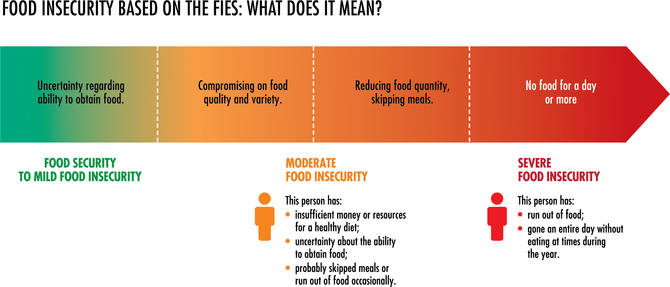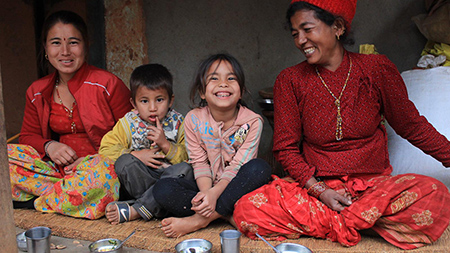Much has changed since 1974, when FAO first began reporting on the extent of hunger in the world. The world population is growing steadily and is increasingly urbanized. Technology is evolving incessantly and the economy is more and more globalized. At the same time, there are worrying global trends in malnutrition, including a rapid rise in overweight and obesity, even as forms of undernutrition persist. The way food is produced, distributed and consumed worldwide has also changed dramatically. This vastly different world calls for new ways of thinking about hunger and food insecurity.
As part of its mandate, FAO strives to eradicate hunger, food insecurity and all forms of malnutrition. Supporting the livelihoods of small-scale food producers, improving the resilience of food production systems and encouraging the sustainable use of natural resources are all key to fulfilling this mandate and achieving Sustainable Development Goal 2 (SDG2), a world without hunger, food insecurity and malnutrition.
What is hunger?
Hunger is an uncomfortable or painful physical sensation caused by insufficient consumption of dietary energy. It becomes chronic when the person does not consume a sufficient amount of calories (dietary energy) on a regular basis to lead a normal, active and healthy life. For decades, FAO has used the Prevalence of Undernourishment indicator to estimate the extent of hunger in the world, thus “hunger” may also be referred to as undernourishment.
What is food insecurity?
A person is food insecure when they lack regular access to enough safe and nutritious food for normal growth and development and an active and healthy life. This may be due to unavailability of food and/or lack of resources to obtain food. Food insecurity can be experienced at different levels of severity. FAO measures food insecurity using the Food Insecurity Experience Scale (FIES) shown below:

How are hunger and food insecurity related?
When someone is severely food insecure, they have run out of food and gone a day or more without eating. In other words, they have most likely experienced hunger.
Severe food insecurity is one extreme of the scale, but even moderate food insecurity is worrisome. For those who are moderately food insecure, access to food is uncertain. They might have to sacrifice other basic needs, just to be able to eat. When they do eat, it might be whatever is most readily available or cheapest, which might not be the most nutritious food. The rise in obesity and other forms of malnutrition is partly a result of this phenomenon. Highly processed foods that are energy-dense, high in saturated fats, sugars and salt are often cheaper and easier to come by than fresh fruits and vegetables. Eating those foods may mean your daily requirement of calories is met, but you are missing essential nutrients to keep your body healthy and functioning well. In addition, the stress of living with uncertain access to food and going periods without food can lead to physiological changes that can contribute to overweight and obesity. Children facing hunger, food insecurity and undernutrition today may have a higher risk of overweight, obesity and chronic diseases like diabetes later in life. In many countries, undernutrition and obesity coexist and both can be consequences of food insecurity.
Monitoring hunger and food insecurity in the world
FAO uses multiple indicators to monitor the various aspects of these complex issues.
Two of these indicators, the Prevalence of Undernourishment (PoU) and the Prevalence of moderate or severe food insecurity in the population, based on the Food Insecurity Experience Scale (FIES), are being used to monitor the world’s progress toward achieving SDG2.
The PoU and the prevalence of food insecurity based on the FIES give different perspectives and utilize very different methodologies and sources of data.
Between 691 and 783 million people faced hunger in 2022
The Prevalence of Undernourishment (PoU) is FAO’s traditional indicator used to monitor hunger at the global and regional level and is based on country data on food availability, food consumption and energy needs. It estimates the adequacy of a population’s dietary energy intake. Historically, the number of hungry people in the world (between 702 and 828 million) has been derived using this approach. PoU estimates cannot be sufficiently disaggregated to be able to identify specific vulnerable populations within countries, which is a limitation for monitoring the very ambitious goal of Zero Hunger in an agenda that aims to leave no one behind.
The prevalence of moderate or severe food insecurity in the population, based on the Food Insecurity Experience Scale (FIES) is an estimate of the percentage of a country’s population that faces difficulties in accessing enough safe and nutritious food for normal growth and development and an active and healthy life. The data is collected through direct interviews by asking people about experiences associated with constrained access to food. The FIES is capable of providing measures of food insecurity at the individual or household level and at different levels of severity. Estimates can be compared across countries and sub-populations within countries. Rather than only national trends, this methodology can be used to highlight the “who” and “where” of the of food insecurity, answering the questions: which populations are the most food insecure, and where are they located?
In monitoring the progress toward SDG 2, this FAO indicator measures the proportion of the population that is experiencing moderate or severe food insecurity in a population.
People experiencing moderate food insecurity have reduced the quality and/or quantity of their food and are uncertain about their ability to obtain food due to lack of money or other resources. Moderate food insecurity can increase the risk of some forms of malnutrition, such as stunting in children, micronutrient deficiencies or obesity in adults.
People experiencing severe food insecurity have run out of food and, at the most extreme, have gone days without eating. This group of people are those we call the “hungry”. The number of severely food insecure people derived from the FIES complements the number of hungry people determined based on the POU.
Global, regional and country-level estimates of the POU and of the prevalence of moderate or severe food insecurity are disseminated annually in the State of Food Security and Nutrition in the World flagship report as well as on FAOSTAT and the UN Global SDG Indicators Data Platform. The objective is regular monitoring of chronic food insecurity in all countries. This differs from the Global Report on Food Crises which focuses on acute food insecurity in a limited number of countries and territories affected by food crises as assessed based on analytic approaches such as the Integrated Food Security Phase Classification/Cadre Harmonisé.


